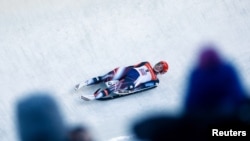There are plenty of reasons why the sport of bobsleigh is sometimes referred to as Formula One on ice but few as obvious as Italy’s World Cup sleds.
Resplendent in Ferrari red, and with a set of team sponsor Pirelli's P-Zero tires painted on the sides, they are even liveried to look like racing cars.
Ferrari, Formula One’s most glamorous and successful team, have worked with the Italian federation, whose sleds run without sponsor branding at the Olympics, since 2010 and in the run-up to next month's Pyeongchang Winter Games.
Former rivals BMW, title sponsors of the World Cup, have long partnered the U.S. bobsleigh team while McLaren teamed up with Britain’s bob and skeleton athletes for the 2014 Sochi Games in Russia.
“There's always the link between the Formula One companies, or any motor company, and skeleton and bobsleigh,” says Rachel Blackburn, the engineer who has been involved in Britain’s skeleton program since 2006 and who used to work for McLaren.
“There's the Ferrari sleds and the BMW sleds, ... when we were at McLaren it kind of made a good story,” she told Reuters by telephone from her home in Dubai.
That somewhat manufactured rivalry has died down in the years since Sochi, with McLaren no longer involved and Ferrari’s presence distinctly low key.
But the worlds of grand prix motor racing and sliding sports still have plenty in common.
Bobsleigh, luge and skeleton are among the fastest of Olympic sports, with bobsleds reaching speeds in excess of 150 kph (93 mph). Drivers are subjected to gut-wrenching G-forces, crashes can be fatal.
And then there is the ongoing debate about cost controls, the direction of future rules, preserving a level playing field and obsessive secrecy — all endlessly recurring themes in Formula One.
Tea-tray
Blackburn said skeleton, where riders hit 130 kph (81 mph) on what has glibly been compared to an oversized tea-tray, sits somewhere between Americas Cup yachts and Formula One cars in terms of speed and aerodynamics.
“Applied engineering is far more interesting than the pure stuff, so when its applied to something that's fun and exciting it does make it a lot easier to solve problems,” she said.
“There is the Americas Cup, sailing, Formula One and the high speed ice sports as well. It’s the same concept. In the skeleton we’re still looking at chassis dynamics, it’s not dissimilar.”
The Briton, who lent her name to the “Project BlackRoc” that helped Amy Williams and Lizzy Yarnold win golds in 2010 and 2014, now chairs the world governing body’s Skeleton Material Committee.
James Roche, the aero expert and other half of “BlackRoc” who also went to McLaren after the 2010 Games, married Yarnold last year and has turned his talents to Americas Cup yachting with Ben Ainslie Racing.
Together Blackburn and Roche helped design the “super sled,” also known as “Mervyn,” that may help Yarnold become the first British athlete to defend a Winter Olympics title.
Yarnold spoke before the season started about the thrill of being presented with new developments for the Games, and the accompanying buzz of secrecy.
Blackburn, who now has her own consultancy, compared that to a Formula One team testing pre-season while keeping the latest front wing developments firmly under wraps until the opening race.
“Athletes come and go and you don’t want your work getting spread around the world before you’ve made it work. so there is quite a bit of secrecy,” she said. “With some of the things ... they will just be brought out at the very last minute. They’ll be things we’ve worked on but not rolled out until the Games because we don’t want Germany, Canada, America copying something.”
Painful process
Although the sled’s structural innards are seen only by the competing nation and competition inspectors, Blackburn said there were few real secrets from past Games as coaches and athletes moved around.
Most of the loopholes have also been closed and Blackburn, an advocate for change, said it remained “an incredibly painful process” to bring the rules into a more modern era and encourage innovation.
A skeleton sled has a carbon fiber pan on the outside but the chassis is made from steel, a material that is both heavy and expensive as well as distinctly low-tech compared to other options.
“There's lots of different materials now that could be used that are much easier and cheaper to manufacture,” said Blackburn. “With the onset of 3-D printing, if somebody wanted to get something custom made they could probably do that now but not with steel. The fact that we still limit things to steel makes it quite a lot trickier for small nations now to get things made, especially to the precision that skeleton sleds require given the speeds and the temperatures they are going through.”










